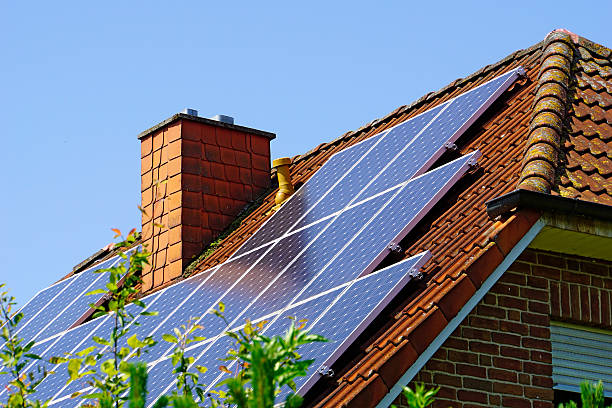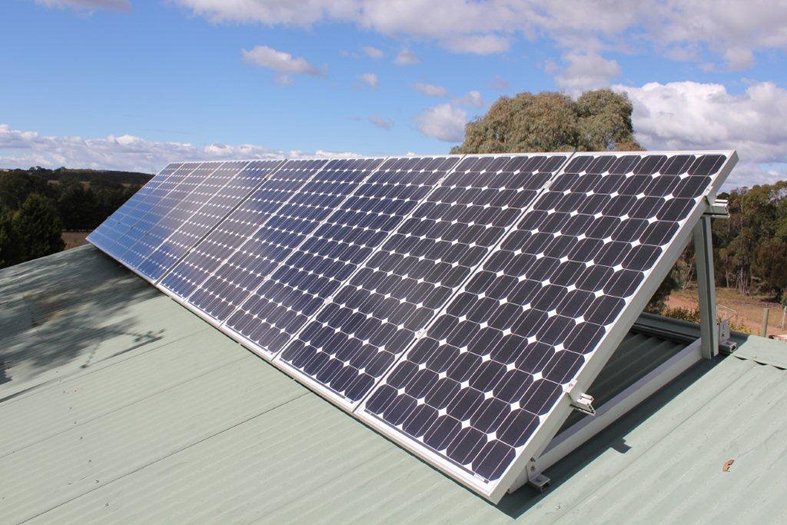Last update May 28th, 2024 at 10:45 am
As solar panels produce electricity from solar energy, their efficiency will highly depend on the amount of sunlight that hits the solar cells. Because of this, the angle and orientation of your solar panels play an essential role upon installation.
Many factors may affect how your panels should be mounted, including your roof angle and orientation and where your home is located.

What is the optimal solar panel angle?
In general, solar panels will work most efficiently when they are positioned at a 90-degree angle to the sun. In other words, solar panels should be installed perpendicular to the light emitted from the sun.
The optimal angle will depend on where you are located. Australians live in the southern hemisphere, and this means that homes with north-facing rooftops are perfect for solar installations (as these will produce energy more efficiently).
Remember, the rooftop angle might vary from home to home because of different architecture.
Ideal solar panel angle in different Australian cities
In Australia, the ideal angle to mount solar panels will normally equal the location’s latitude angle. In other words, it would be ideal if your roof pitch equals the latitude angle. The panels should optimally be installed at the same angle as your roof.
To make this easier to understand, we will give you an example. Assuming that you live in Sydney, the ideal roof pitch is 34 degrees as this equals the New South Wales latitude angle of 33.86 degrees.
Here is the ideal angle to mount solar panels in some major Australian cities:
- Darwin: 12.5 degrees
- Perth: 31.9 degrees
- Adelaide: 34.9 degrees
- Melbourne: 37.8 degrees
- Hobart: 42.9 degrees
- Brisbane: 27.5 degrees
- Sydney: 33.9 degrees
The optimal angle may differ between winter and summer
It might be tricky to achieve the perfect solar panel angle at all times, as the winter sun is significantly lower angled than the summer sun.
If you want to achieve the optimum angle during winter, you might angle the panels with a greater tilt. This will ensure a higher exposure to the low-angled winter sun. Because of this, you might consider adding 15 degrees to the latitude angle.
However, in most cases, Australians have solar panels mounted at the same angle as their rooftops. This is because of the extra costs that are associated with installing solar panels at the optimum angle.
Solar output based on the angle
There are several factors that might affect the efficiency and power outcome of a solar panel. When calculating the expected solar energy output, you should consider both rooftop orientation, roof angle, location and panel efficiency.
If your solar panels are not mounted at the optimum angle, this might affect the solar output. But how much? If your roof pitch is somewhere between 10 and 15 degrees lower or higher than the latitude angle, this will only affect the solar output by 1 to 1.5 %.
If you are located in Melbourne and have solar panels installed on a rooftop with a 23-degree pitch (and not the optimal 37.8-degree pitch), this would mean that the solar panels lose 1 to 1.5% of their max output. This is not very significant.
Should I go solar if my rooftop is flat?
The flatter a rooftop is, the bigger the solar output loss will be. If you live in Melbourne and have a completely flat rooftop, this could mean that your solar panels only produce 86% of the power they optimally could.
The solar output for flat rooftops might vary from location to location. Here is the expected solar output (in %) for flat rooftops in different Australian cities:
- Melbourne: 86%
- Sydney: 87%
- Perth: 86%
- Brisbane: 90%
- Hobart: 82%
- Adelaide: 87%
- Darwin: 96%
However, if your rooftop is flat, it does not mean that solar technology is not right for you. In most cases, it is possible to install a mounting device to make the orientation more beneficial.
The mounting device will also tilt the panels enough to make rainwater drip off and clean the panels. Remember, dust and dirt might reduce panel efficiency, so it is important to keep the panels as clean as possible.

How to go solar?
If you want to go solar, you should first find an installer approved by the Clean Energy Council (CEC). Remember, only CEC-accredited installers and products will be eligible for the government STC rebate.
The installer will help you find the perfect solar panel system for your household. When it comes to mounting the panels, this is something the installer will take care of. If it is necessary, the installer might recommend a mounting device to increase panel efficiency.
Going solar will give you many benefits, including lower electricity bills and access to green solar power. Find an installer today!